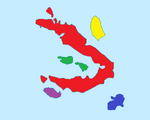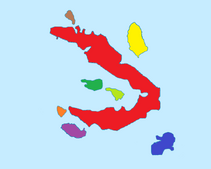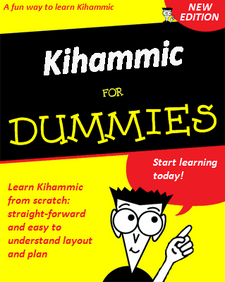| Socialist Republic of Kihāmát Kihāmátī aguntokôvanatī́zô agənamīšā́n
| |||||
|---|---|---|---|---|---|
| |||||
|
Motto: Pá mamûnám ontā́ bán | |||||
|
Anthem: Lố Kihāmátī agənamainámas | |||||
 Kihāmát on Google Maps | |||||
| Capital and largest city |
Talná | ||||
| Official languages | Kihā́mmic | ||||
| Recognised regional languages | Kétassic, Kyánnic, Lôppic, Lower Fnórric, Upper Fnórric | ||||
| Unofficial language | Church Kihā́mmic | ||||
| Ethnic groups (2008) | Kihā́mmic (69.6%), Lôppic (11.4%), Kétassic (8.8%), Fnórric (7%), other (3.1%) | ||||
| Demonym | Kihā́mmic | ||||
| Government | unitary socialist state, parliamentary republic | ||||
• Premier |
Īzván Rátkan Yôfánī-Mā́rī | ||||
• Deputy Premiers |
Čalsá Harīná Ádamī-Kátī Ázô Báktor Īzvánī-Yûnī́ | ||||
• Speaker |
Bástan Míkalô Kázunī-Lûnī́ | ||||
| Legislature | National Parliament | ||||
| Establishment | |||||
• Unification |
17 July 1316 | ||||
• Republic |
30 September 1638 | ||||
• Communist state |
27 August 1883 | ||||
• Interim govt |
28 September 1955 | ||||
• Socialist state |
11 January 1957 | ||||
• New constitution |
6 April 1981 | ||||
| Area | |||||
• Total |
124,846 km2 (48,203 sq mi) (99) | ||||
• Water (%) |
negligible | ||||
| Population | |||||
• 2011 estimate |
7,970,341 (96) | ||||
• 2008 census |
7,885,289 (96) | ||||
• Density |
63.2/km2 (163.7/sq mi) (149) | ||||
| GDP (PPP) | 2011 estimate | ||||
• Total |
$201 billion | ||||
• Per capita |
$25,197 | ||||
| GDP (nominal) | 2011 estimate | ||||
• Total |
$151 billion | ||||
• Per capita |
$18,995 | ||||
| Currency | horá (ʜ) (KAH) | ||||
| Time zone | Pacific Standard Time (PST) (UTC-8) | ||||
| Date format | dd/mm/yyyy | ||||
| Drives on the | left | ||||
| Calling code | +77 | ||||
| Internet TLD | .ka | ||||
Kihāmát, officially known as the Socialist Republic of Kihāmát (Kihā́mmic: Lố Kihāmátī aguntokôvanatī́zô agənamīšā́n), is an island nation comprising of eight closely grouped islands in the North Pacific Ocean, approximately 1700mi (2800km) off the coast of Mexico. The islands have been unified as one sovereign state since AD 1316, prior to this there had been five separate royal families ruling their own separate kingdoms. Tensions between the five countries ultimately resulted in the the Kihā́mmic Civil War. The Civil War commenced in late 1298 and did not finish until the accord of 1316, which effectively saw the largest of the kingdoms assume control of the others and thus the Kingdom of Kihāmát (Lố Kihāmátī yegašā́n) was born.
History[]
Early history[]
The islands that now make up Kihāmát had been five separate kingdoms each with their own separate royal family, how the five kingdoms were divided up is shown on the coloured map:

The five former kingdoms, now part of modern-day Kihāmát.
- Red: the Kingdom of Raibáûī (Lố Raibáûī yegašā́n)
- Yellow: the Lôppic Kingdom (Lố Yegašā́n lôpatī́zô)
- Blue: the Kétassic Kingdom (Lố Yegašā́n ketasatī́zô)
- Purple: the Duchy of Rātəná (Lố Rātənī́ yāšā́n)
- Green: the Kingdom of the Fnoráts (Lố lámī Fnoratámī yegašā́n)
The five countries had been experiencing increasing tensions during the thirteenth century, which culminated in the break out of civil war in late 1298. The Kihā́mmic Civil War lasted almost eighteen years, until 1316. An accord between the five monarchies, on the 17 July 1316, effectively saw the largest of the kingdoms assume control of the others, uniting the kingdoms resulting in the formation of a new state; the Kingdom of Kihāmát.
The Republic[]
This new government was highly centralised, ruled by the absolute monarch and a selected advisory council. The monarchy lasted for over three hundred years, but was replaced by a republic in 1638, after a popular revolution. The Republican Revolution was brought about by prolonged food shortages due to the mismanagement of farming land by the monarchical régime. The government that replaced this monarchy was the Kihā́mmic Republic (Lố Agənamīšā́n kihāmatī́zô), declared on 30 September 1638. The Republic replaced the old system of governance with a president and a non-partisan parliament. General elections to the parliament would take place every four years and presidential elections would occur at the same time. During the 1680s unofficial political allegiances that had developed led to the creation of the nation’s first political parties – the first of which was the small Kihā́mmic Nationalist Party. As of 1691 it was a requirement to be a member of registered political party in order to be a member of the Parliament, presidential elections were abolished and the leader of the party with the most votes assumed the office of President.
Communist era[]
The Kihā́mmic Republic remained continuously stable until the early 1870s, when a series of floods devastated the islands in between 1869 and 1871. This meant that once again food was in short supply. After the natural disasters there were numerous protests throughout the country criticising the government’s handling of the situation. This was the start of the ascent of left-wing politics in Kihāmát. In 1881 the general election showed this huge shift of political allegiance and thought. The staggering results of the election are shown below:
- Communist Party of Kihāmát - 64.2%
- Kihā́mmic Socialist Party - 21.6%
- Liberal Party of Kihāmát - 7.1%
- Conservative Party of Kihāmát - 5.3%
- Kihā́mmic Nationalist Party - 1.1%
- Kihā́mmic Monarchist Party - 0.7%
A year and a half after the Communist Party gained control of the Parliament, on the 27 August 1883, the party announced the foundation of a new Kihā́mmic state; the Communist Federation of Kihāmát (Lố Kihāmátī hartamôvanatī́zô kalāšā́n). The parliamentary system was replaced by a less centralised non-partisan system, whereby the country was split into 5 autonomous regions, with a supreme council of government officials on Raibáûī.
Modern history[]
By the end of World War II in 1945, in which Kihāmát played no part, the Communist régime had become more and more centralised and was met with popular protests during the 1940s. The protests became more and more frequent during the early 1950s, the government resisted the popular appeals and elections were abolished in early 1953 (the last elections having taken place in 1949) as the government saw the public as too ill-minded to make a rational judgement when voting. This only heightened public discontent and marked the start of the anti-governmental revolt, the Libertarian Revolution. The driving force behind the revolution was the Black Flag movement. The régime and on 28 September 1955 the country came to a stand still. The Parliament Building in the capital, where the National and Federal Councils convened, was stormed by protesters and the communist government ousted from power, replaced by an interim government made up of politicians of various political persuasions. Political parties began to reform and elections were held on 1 January the following year, the results of which are shown below:
- Kihā́mmic Socialist Party - 31.6%
- Conservative Party of Kihāmát - 29.3%
- Liberal Party of Kihāmát - 17.2%
- Independent - 8.2%
- New Party of Libertarian Kihā́mmic Communists - 7.1%
- New Kihā́mmic Nationalist Party - 5.4%
- Party For A New Kihā́mmic Kingdom - 0.7%
- Communist Party of Kihāmát - 0.5%
Following these election results the elected interim government held a referendum seven months later, on 2 July, concerning the type of government to use. The options proposed and results of the referendum are displayed below:
- Socialist state: democratic elections every five years, collective leadership rather than a head of state, decentralised semi-autonomous regional control, small scale regional privatisation in certain industries, regular referenda on important matters of state. - 38.4%
- Parliamentary republic: democratic governmental and presidential elections every five years, semi-decentralised regional control, privatised economy. - 31.7%
- Federative republic: regional autonomy, regional elections every four years, supreme control by a supra-regional body, supra-national and presidential elections every six years, privatised economy. - 24.6%
- Communist state: semi-democratic elections every six years, elections for Premiership every five years, centralised governmental control, no privatisation. - 4.9%
- State capitalist nation: Centralised non-partisan system, semi-democratic elections every five years, election of Premier by committee, no privatisation, highly centralised economy. - 0.4%
On 11 January 1957 following result of the July 1956 referendum the Socialist Republic of Kihāmát was proclaimed as the successor to the interim government. Kihāmát has not undergone another régime change to date. The only significant change since the formation of the state was the transition in 1981 from a leaderless parliament to a pyramid of leadership. This reform came into effect on 6 April 1981.
Geography[]

The eight islands of Kihāmát.
The country of Kihāmát is entirely made up of an archipelago and thus completely surrounded by water. The island cluster comprises of eight separate islands, shown on the diagram to the left.
- Red: Raibáûī is Kihāmát's main island, making up nearly 75% of the country's area and accounting for almost 60% of the population.
- Yellow: Laāláûī is the second largest island and also has a population approaching a million. The island is the home of the Lôppic people.
- Blue: Tōrnáûī is the native land of the Kétassic people. The name "Tōrnáûī" derives from the Kihā́mmic words "tṓrnamô" and "báûī", meaning "distant" and "land" respectively.
- Purple: Rātəná has a population of just over 500,000 people and is the main island where Kyánnic is spoken. It is also home to many Kétassic people.
- Green: Upper Fnorát is one of the native islands of the Fnórric people, it is slightly bigger than its neighbour.
- Lime: Lower Fnorát is the second of the two Fnoráts and is also slightly smaller than its counter-part.
- Brown: Rock Island off the very northern-most part of Raibáûī is one of the smallest islands in Kihāmát. It was until recently extremely sparsely populated.
- Orange: the Rock of the Church is the smallest and most densely populated island in Kihāmát. It gets its name from its mountainous topology and the fact that it was (and, to some extent, remains) the religious and monastic centre of Kihāmát.
The islands were created mainly by volcanic activity, however there are no longer any active or dormant volcanoes on the islands. This past activity has created stunning geological features and landscapes.
Weather[]
Climate data for Talná, Kihāmát:
| Month | Jan | Feb | Mar | Apr | May | Jun | Jul | Aug | Sep | Oct | Nov | Dec | Year |
| Record high, °C | 39.1 | 36.9 | 34.7 | 34.9 | 35.1 | 33.5 | 29.8 | 27.6 | 29.1 | 32.8 | 34.3 | 34.9 | 39.1 |
| Daily mean, °C | 28 | 26 | 25 | 25 | 26 | 22 | 18 | 17 | 19 | 21 | 23 | 25 | 23 |
| Record low, °C | 11.8 | 10.2 | 9.1 | 7.1 | 6.0 | 0.9 | -0.2 | -2.0 | -1.7 | -0.1 | 3.1 | 7.5 | 8.1 |
| Precipitation, mm | 81 | 184 | 95 | 79 | 64 | 41 | 21 | 2 | 6 | 17 | 26 | 69 | 685 |
| Avg days of precipitation | 9 | 14 | 11 | 8 | 6 | 4 | 2 | 1 | 1 | 3 | 5 | 8 | 72 |
| Avg hours of sunshine |
Language[]
- See also: Panlaffic languages

Kihā́mmic is the country's most spoken language.
Kihāmát has six officially recognised languages, all of which are from the Panlaffic language isolate family. The six languages are Kihā́mmic, Lôppic, Kétassic, Upper and Lower Fnórric and Kyánnic.
The dominant language on the islands is Kihā́mmic, it is Kihāmát's national language and as well as the official regional language of the Island of Raibáûī, Rock Island and the Rock of the Church. Used throughout the nation as a lingua franca, Kihā́mmic has more than five million native speakers and is the second language of around two million others.
Lôppic is the official language of the Island of Laāláûī and is associated with the Lôppic ethnic group. After Kihā́mmic, it is the most spoken Panlaffic language, with nearly 900,000 native speakers and several million people in Kihāmát speak it as a second language.
The Island of Tōrnáûī's official regional language is Kétassic, which is associated with the synonymous ethnic group. It is the third most spoken Panlaffic language with approximately 675,000 native speakers, almost exclusively on Tōrnáûī.
There are two varieties of the Fnórric language which correspond to the two island, Upper and Lower Fnorát. Together the two languages have around 150,000 less native speakers than Kétassic.
Kyánnic is one of the least spoken legally recognised Panlaffic languages. There are just under 450,000 native speakers of the language, which is the official regional language of the Island of Rātəná.
The only other extant Panlaffic language is Church Kihā́mmic. It is used primarily as a liturgical language and has no official status in the country. The language is kept alive by its liturgical use and there are in fact a few people who are brought up as native speakers, mainly by intensively religious parents. The latest figure, according to the 2008 census, is 54,878.
Approximately 0.6% of Kihāmát's population (around 46,000 people) speak non-Panlaffic languages as their native language. The most spoken is Spanish, with over 18,000 speakers. Whereas Māori has a mere 18 native speakers. A table of the non-Panlaffic languages in Kihāmát (according to the 2008 census) is shown below:
| No. of native speakers | Language | Language family |
| 18,844 | Spanish | Romance |
| 11,657 | Portuguese | Romance |
| 5,437 | English | Germanic |
| 4,239 | French | Romance |
| 3,271 | German | Germanic |
| 1,244 | Russian | Slavic |
| 507 | Dutch | Germanic |
| 369 | Yiddish | Germanic |
| 332 | Hawaiian | Oceanic |
| 124 | Samoa | Oceanic |
| 32 | Tongan | Oceanic |
| 18 | Māori | Oceanic |
Demographics[]
Religion[]
- See also: Religion in Kihāmát
Despite the freedom of religion afforded to citizens Kihāmát is one of the most irreligious countries in the world. According to the census of 2008 almost sixty per cent of people in Kihāmát identified as irreligious or declined to provide an answer, nearly fifty per cent said that they did "not believe in a super-natural being or super-natural beings of any kind", around than thirty per cent identified as "deist", "monotheist" or "polytheist" and nearly twenty per cent said they were "unsure as to the existence of a super-natural being or super-natural beings".
| Religion | Percentage | No. of people |
| Irreligious (or no answer) | 57.74 | 4,552,966 |
| Christianity | 24.87 | 1,961,071 |
| Kihā́mmic Paganism | 11.04 | 870,536 |
| Islam | 2.03 | 160,071 |
| Buddhism | 1.87 | 147,455 |
| Other | 2.45 | 193,190 |


